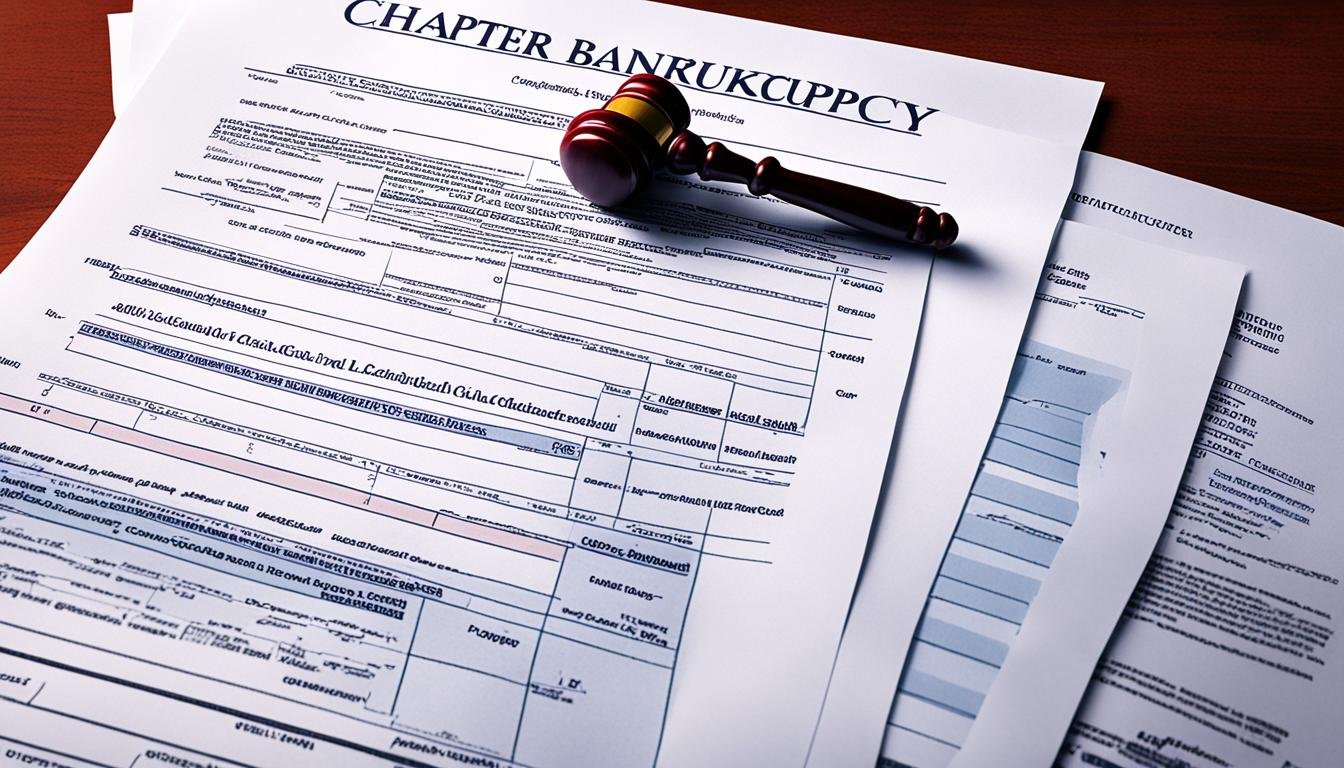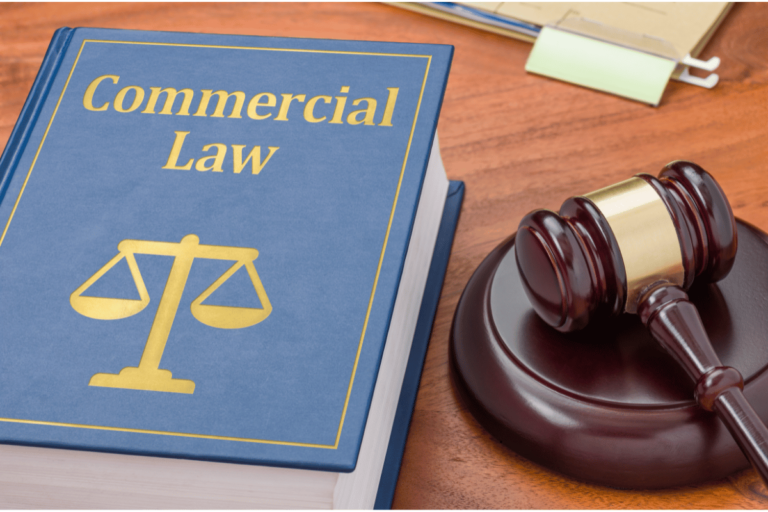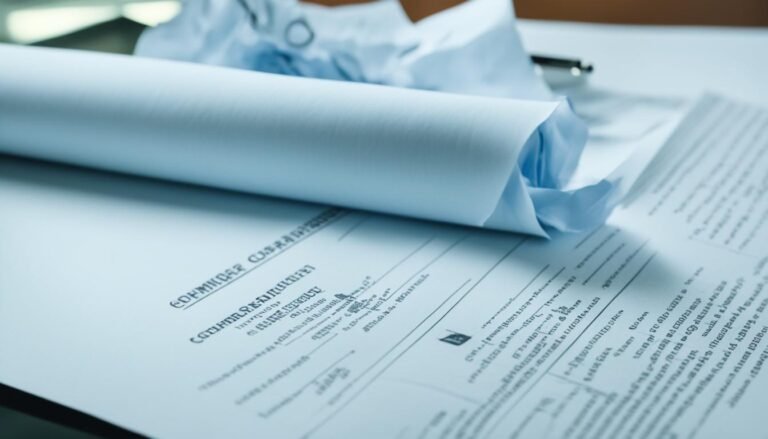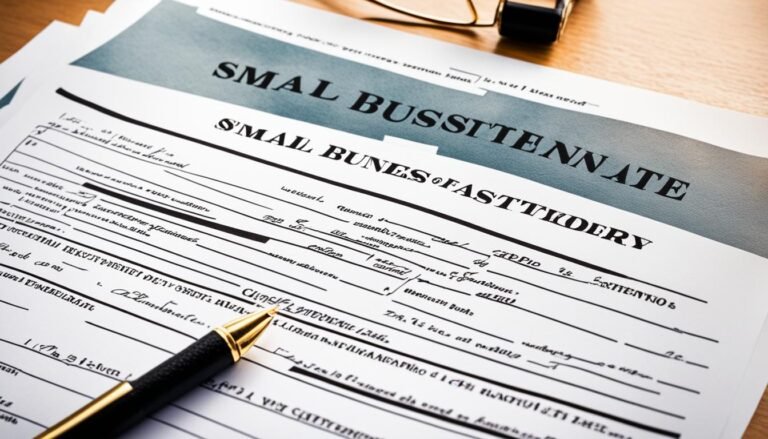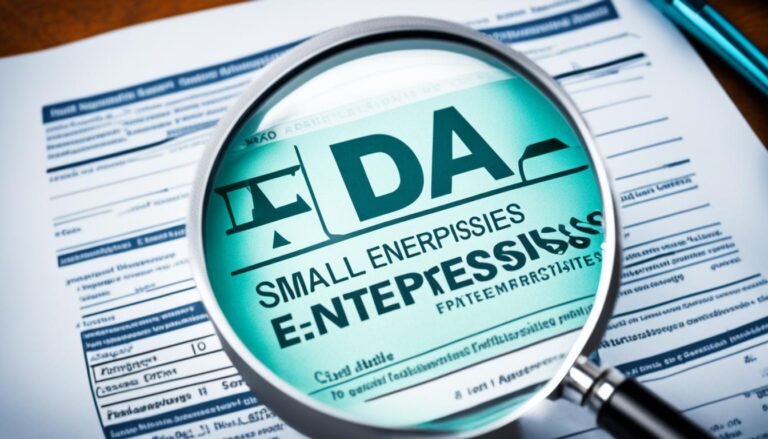Chapter 13 Bankruptcy: What SMEs Need to Know
Did you know small business bankruptcies are rising? In September 2023, Chapter 11 filings jumped by 29%. This increase signals tough times for small and medium businesses. It shows why knowing about bankruptcy and finding debt relief is crucial.
Key Takeaways:
- Small business bankruptcies have increased by 29% in September 2023 compared to the previous year.
- Chapter 13 bankruptcy provides SMEs with options for debt relief and asset protection.
- Understanding the bankruptcy process and exploring alternatives is crucial for SMEs facing financial challenges.
- Seeking advice from credit counselors or financial advisors can help SMEs navigate their financial difficulties.
- Debt consolidation loans and alternative funding options should be considered before filing for bankruptcy.
Small Business Bankruptcy Statistics
In September 2023, Chapter 11 filings for businesses were up by 29% from the previous year. Commercial bankruptcy filings also grew by 16% in September 2023, compared to September 2022.
In Q3 2023, the small business loan delinquency rate hit 0.95%. This shows that many small businesses face financial difficulties. From September 30, 2022, to the same date in 2023, 17,051 business bankruptcy cases started. These included 9,435 Chapter 7 cases and 6,097 Chapter 11 cases. In the whole of fiscal year 2022, there were 7,631 Chapter 7 and 4,274 Chapter 11 cases.
| Business Bankruptcy Statistics | |
|---|---|
| Chapter 11 Filings | 29% increase in September 2023 compared to September 2022 |
| Commercial Bankruptcy Filings | 16% increase in September 2023 compared to September 2022 |
| Small Business Loan Delinquency Rate | Q3 2023: 0.95% |
| Business Bankruptcy Cases (12 months ending September 30, 2023) | Total: 17,051 cases |
| Chapter 7 Cases: 9,435 | |
| Chapter 11 Cases: 6,097 | |
| Business Bankruptcy Cases (fiscal year 2022) | Chapter 7 Cases: 7,631 |
| Chapter 11 Cases: 4,274 |
These numbers show a tough time for small businesses. Chapter 11 filings, commercial bankruptcy, and loan delays are all increasing. It’s essential for small and medium enterprises to know their choices. They should also seek advice from experts when facing financial problems.
Rise in Small Business Bankruptcies
Small business bankruptcies, especially Chapter 11, can show if the economy might slow down. Many small companies deal with lots of issues, which can hurt their money situation. Things like not enough workers, up and down customer needs after the pandemic, and prices going up can all mess with how well small businesses do.
It’s harder for smaller companies to borrow money when interest rates are high and when it’s tough to get loans. They often serve customers who live around them. So, if people don’t buy as much from these businesses, it hits their earnings hard.
But, it’s not just the economy that can make them fail. Bad money management, not looking into the market enough, and a lot of competition can also be big problems. Knowing about these issues and figuring out ways to deal with them can help business owners steer their companies away from failure.
Here’s a table showing how Chapter 11 bankruptcies went up over the last two years:
| Year | Chapter 11 Filings |
|---|---|
| 2022 | 2,300 |
| 2023 | 2,970 |
The table clearly shows that there are more small businesses struggling. This growing number of bankruptcies means we need to do more to help them. That might mean making it easier for them to get money, teaching them better ways to manage their finances, and giving them advice through mentorship programs.
Types of Business Bankruptcies
When a small business is in financial trouble, bankruptcy might be considered to deal with debt. Different types of business bankruptcies exist, focusing on the situation and aims of the company. Knowing these choices can help business owners decide on the best way forward. Options include Chapter 7, Chapter 11, Chapter 11 subchapter V, Chapter 11 small business case, and Chapter 13.
Chapter 7 bankruptcy means selling off a business’s assets to pay debts. Non-exempt assets are sold, and the money goes to those the business owes. After this, the business is usually shut down.
Chapter 11 bankruptcy lets businesses deal with debts and make a plan to pay them back. Commonly used by larger businesses, it’s a way to lower debts, talk with creditors, and keep running.
Chapter 11 subchapter V is like Chapter 11, but it’s for small businesses. It makes the process of reducing debts simpler and cheaper. This is meant to help small businesses stay afloat.
Chapter 11 small business case is tailored for small businesses too. A U.S. trustee oversees a quicker debt restructuring process. It lets small businesses keep managing while they pay off debts.
Chapter 13 bankruptcy is mainly for individuals but can help business owners with personal debts. It’s a way for them to handle their finances and protect what they own.
Each bankruptcy type has rules on who can use it, how to file, and what may happen next. Talking to a lawyer or financial advisor experienced in business bankruptcy is wise. They can guide business owners to the best choice for their situation.
Comparison of Business Bankruptcy Types
| Bankruptcy Type | Purpose | Key Features |
|---|---|---|
| Chapter 7 | Liquidation of assets to repay debts | Non-exempt assets sold to repay creditors |
| Chapter 11 | Reorganization of debts and development of a repayment plan | Negotiations with creditors, continued operations |
| Chapter 11 subchapter V | Streamlined reorganization for small business debtors | Simplified process, support for small businesses |
| Chapter 11 small business case | Reorganization of debts under U.S. trustee supervision | Retention of control, specialized support for small businesses |
| Chapter 13 | Organization of personal debts and creation of a repayment plan | Protection of personal assets, debt consolidation |
Alternatives to Business Bankruptcy
Small and medium-sized enterprises (SMEs) should first look at other options before bankruptcy. They can get help from credit counselors or financial advisors for advice. These experts help manage debt and boost cash flow.
Debt consolidation loans can be a big help. They merge several debts into one, easing the financial load. This move can also cut down on interest rates.
SMEs might try to operate more efficiently to save money. They could win grants or use crowdfunding for more money. Also, they can try to find new ways to make money which can lead to growth and stability.
It’s crucial for SMEs to think through their choices. They should consider the future effects of each option. Working on the business part-time while trying to get more funds can be risky. It might add more debt and shake things up financially.
Pros and Cons of Alternatives to Business Bankruptcy
| Alternative | Pros | Cons |
|---|---|---|
| Credit Counselors | Expert guidance and financial management advice debt negotiation and repayment plans |
Costs associated with credit counseling services potential impact on credit score |
| Financial Advisors | Comprehensive financial planning investment strategies and portfolio management |
Professional fees potential investment risks |
| Debt Consolidation Loans | Simplifies debt repayment potential for reduced interest rates |
Additional loan obligations qualification requirements |
| Business Funding | Access to capital for ongoing operations potential for business expansion |
Strict application and approval processes collateral or equity requirements |
| Revenue Generation | Opportunity for business growth and financial stability diversification of income streams |
Requires strategic planning and execution time and resource investments |
What Happens When a Business Files for Bankruptcy
When a business decides to file for bankruptcy, it faces several steps. These are crucial for SMEs. They include a petition, submitting documents, and getting credit counseling. There are also meetings with the court and creditors. Finally, a plan is created to guide the bankruptcy process.
Petition and Documentation
First off, the business files a petition with the bankruptcy court. This step begins the bankruptcy process officially. The petition shares details about the business’s money situation and debts. It’s supported by documents that back up these claims.
Credit Counseling
Before filing for bankruptcy, businesses often go through credit counseling. This step helps the business understand their financial state. It also lets them explore other solutions. The goal is to use this knowledge to make smart choices about bankruptcy.
Meetings with the Court and Creditors
Next, the business must participate in meetings with the court and creditors. At these meetings, the business outlines its financial status. It also addresses any concerns or questions the court or creditors have. The aim is to make progress in the bankruptcy process.
Assets and Payment Plan
During bankruptcy, the business might sell off assets to settle debts. Or it could follow a court-approved repayment plan. This ensures creditors get paid and allows the business to get their finances in order. Business owners must manage their assets wisely. They should stick to the repayment plan to successfully complete the bankruptcy process.
What Happens to Personal Assets When a Business Goes Bankrupt
When a business goes bankrupt, what happens to personal assets depends on bankruptcy type and the business’s structure. It’s key for business owners to know these details. This knowledge helps them plan for protecting their personal wealth.
If it’s a sole proprietorship or a partnership, personal assets might get taken to pay off business debts. Since legally the business and owners are seen as one, personal assets could be used in bankruptcy to pay debts. Owners in these situations should understand how bankruptcy might affect what they own.
But, if the business is incorporated, it’s different. There’s a clear line between what the company owns and what the owner does. This suggests personal belongings should be safe from being taken to cover debts. Yet, stocks or shares the owner has in the business could still be part of the bankruptcy process.
Getting sound legal advice is critical for any business owner. It helps them protect their personal assets and ensures they fully understand their options.
Knowing how bankruptcy can affect personal assets helps business owners choose wisely. This could mean deciding on bankruptcy or finding another way to deal with debt. It’s wise to get help from a bankruptcy lawyer or financial advisor. They can help guide through these tough financial times. And, they can help protect what’s yours.
Examples and Case Studies
Think about John, who owned a small grocery store by himself. He faced tough times and eventually filed for bankruptcy. As a sole owner, his personal stuff could be used to pay what was owed. This case points out the risks of running a business alone.
Then, there’s Sarah who had a manufacturing business under a company name. When her business struggles grew, she filed for bankruptcy. The good news was her personal bank accounts and property were safe from debt collectors. Still, the shares she had in the company might have been affected.
What Happens When a Business Owner Goes Bankrupt
Bankruptcy can happen to both small and big businesses. It’s the end stage of financial troubles. Depending on the type of business, the impact can be quite different.
1. Sole Proprietorship Bankruptcy
In a sole proprietorship, the owner and business are the same. Their personal assets could be sold to pay off debts. This includes their home and car. Bankruptcy can be a way out, but it has big effects on personal finances and future.
2. Incorporation and the Business Owner
With incorporation, the business and owner are separate entities. Debts are mainly the business’s issue if it’s a separate legal entity. If the owner guaranteed business debt, they might still be personally liable.
This is why understanding financial agreements is crucial. For instance, if the owner has taken out a personal loan for the business, they’re responsible, even if the business is incorporated. The owner’s personal assets and credit could be affected.
Stocks an owner holds in the business could also be at risk. Depending on the bankruptcy type and structure of the business, they might lose business equity.
3. Seeking Professional Guidance
Bankruptcy is complicated. Whether in a sole proprietorship or an incorporated business, professional help is key. Bankruptcy attorneys or financial advisors can guide you. They offer advice to protect both personal and business assets.
4. Recovery and Rebuilding
Bankruptcy is a chance to start fresh for business owners. It allows for reviewing and improving strategies. With smart planning, it’s possible to recover from bankruptcy.
“Bankruptcy can be viewed as a chance to start afresh, allowing business owners to reevaluate their strategies, streamline operations, and make necessary changes to ensure long-term success.”
| Bankruptcy Type | Business Structure | Financial Impact |
|---|---|---|
| Sole Proprietorship Bankruptcy | Personal and business assets may be considered for liquidation or restructuring | Significant impact on personal finances |
| Incorporation and the Business Owner | Separation of personal and business assets, unless personal guarantees are in place | Personal assets at risk if personally guaranteed loans or debts exist |
When thinking about bankruptcy, getting advice from legal and financial experts is important. They can help you make the best decisions for your situation.
Conclusion
In conclusion, Chapter 13 bankruptcy is a powerful tool for small and medium businesses (SMEs) facing debt. It lets them keep their assets while creating a plan to pay back what they owe. By picking Chapter 13, these businesses get key benefits. These include protecting their belongings, combining debts, avoiding foreclosure, and ensuring creditor safety.
But, it’s essential for SMEs to fully understand bankruptcy and look at other choices first. They should talk to credit advisors or financial experts to wisely overcome their money problems.
With the right insights and thoughtful planning, SMEs can handle their financial troubles and start anew. Chapter 13 helps erase debt and puts SMEs on the path to financial recovery. This way, they can solidify their future and grow with strength.

